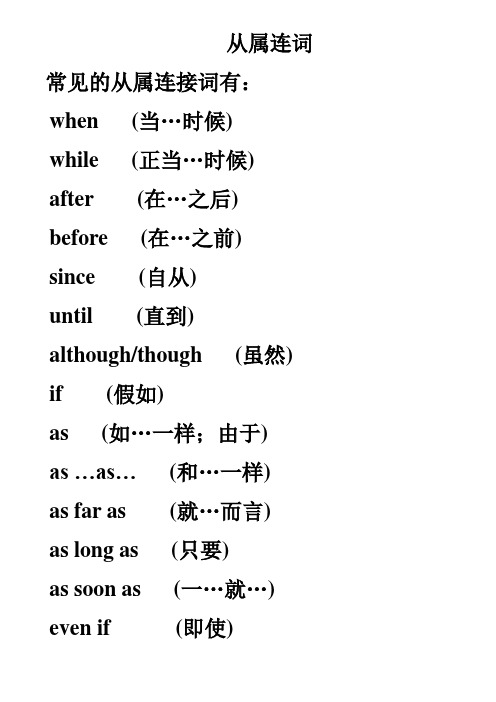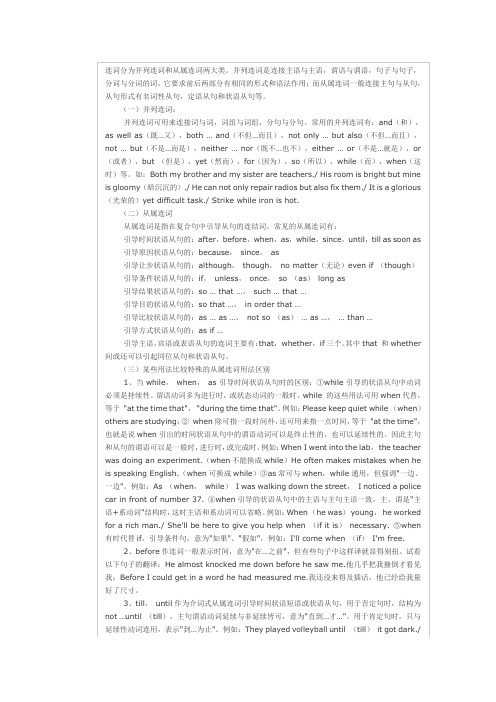从属连词although与though的用法区别与比较
- 格式:pdf
- 大小:219.08 KB
- 文档页数:1

2023年最新的though的用法5篇一、名词+as / though+主语+动词King as he was, he was unhappy. 他虽是国王,但他并不幸福。
Child as he is, he knows to help other. 他虽是个孩子,但却知道帮助别人。
Teacher though he is, he can’t know everything. 他虽然是老师,但也不可能什么都懂。
【说明】其中的动词通常为连系动词,也就是说位于句首的名词是其后连系动词的表语。
另外,要特别注意位于句首的名词前习惯上不用冠词,即使其前有形容词修饰也不用冠词。
比较:Boy as [though] he is, he likes to play with girls.=Though [Although] he is a boy, he likes to play with girls. 他虽是男孩,却喜欢与女孩子玩。
Strong man as [though] he is, General Botha has been severely put to the test during the past few weeks.= Though [Although] he is a strong man, General Botha has been severely put to the test during the past few weeks. 波赛将军虽然坚强,但在过去的数周里也受到了严峻的考验。
二、形容词+as / though+主语+动词Successful as he is, he is not proud. 他虽然成功,但不骄傲。
Improbable as it seems, it’s true. 虽然看起来不太可能,但却是真的。
Stupid as it sounds,I was so in love with her that I believed her. 尽管听起来很愚蠢,我是如此爱她竟然相信了她的话。

从属连词常见的从属连接词有:when (当…时候)while (正当…时候) after (在…之后) before (在…之前)since (自从)until (直到)although/though (虽然) if (假如)as (如…一样;由于)as …as…(和…一样)as far as (就…而言)as long as (只要)as soon as (一…就…) even if (即使)because (因为)unless (除非)than (比…)whether (是否…)in order that…(为了)so…that…(如此…以致)so that…(以便)now that…(现在既然)by the time…(到…时候)every time…(每当)as if…(仿佛)no matter when(或whenever) (无论何时) no matter where(或wherever) (无论在哪里)[辨析](1) because、as、since、for的用法:because(因为)表示原因的语气最强,常表示必然的因果关系,从句一般放在主句后面;另外,回答why的问句只能用because。
as(因为)表示一般的因果关系,语气比because 弱,说明比较明显的原因,它引导的从句可以放在句首也可以放在句尾。
since(既然)表示对方已经知道、无需加以说明的原因或事实。
for(因为)是并列连词,语气较弱,用来补充说明理由或提供一种解释。
如:He is not at school today because he is seriously ill.(他今天没有上学因为他病得厉害)As all of you have got here, now, let’s go to the zoo.(既然大伙儿都到了我们就去动物园吧)I will ask Lin Tao to go with me since you are very busy.(既然你很忙我就叫林涛和我一起去吧)We must be off now for the match starts at 7:00.(我们得走了因为比赛在七点开始)(2)if、whether的区别:表示“是否”时,if和whether同义,引导宾语从句。

考研英语技巧之条件状语从句考研英语技巧之条件状语从句导语:《2016考研英语语法之条件状语从句(一)》里介绍了引导条件状语从句的几个引导词,并且通过中文例子让大家真正理解了条件状语这一从句。
今天作者就考研英语真题中的条件状语从句给大家进行讲解,希望大家对条件状语从句有个更深刻的认识。
句子一:In fact, circumstances seem to be designed to bring out the best in us and if we feel that we have been "wronged"then we are unlikely to begin a conscious effort to escape from our situation.这句话中and连接了两个并列句;并列句一中主语是circumstances,谓语是seem to be designed,被动语态,to bring out the best in us,不定式短语做目的状语;并列句二中有if 引导的条件状语从句--we feel that we have been"wronged"用一般现在时态,主句也为一般现在时态--we are unlikely to begin a conscious effort to escape from our situation。
参考翻译:事实上,环境似乎激发出了我们最好的自己;如果我们感觉自己受到了委屈,那我们就不太可能去有意识地努力逃脱我们所处的情景。
句子二:But if robots are to reach the next stage of laborsaving utility, they will have to operate with less human supervision and be able to make at least a few decisions for themselves--goals that pose a real challenge.If引导条件状语从句--if robots are to reach the next stage of laborsaving utility,使用一般现在时,主语是robots,谓语是are to reach,宾语是the next stage,后边的of介词短语做定语修饰宾语;主句使用一般将来时态,主语是they,代指robots,谓语是will have to operate with和并列谓语be able to make,宾语是less human supervison和并列宾语at least a few decisions,goals that pose a real challenge是整个句子的同位语。

语法填空答题规律一、命题揭秘材料短文特点(1)短文体裁:近三年都是记叙文。
建议:备考练习不局限于此应各种体裁的文章都要练习。
(2)短文题材:生活经历或成语故事,其内容或体现文化内涵,或给人心灵以启迪等。
(3)短文难度:没有超出课标的生词,但有课标单词的派生词。
(4)短文长度:170——200词。
考试大纲说明阅读下面短文, 按照句子结构的语法性和上下文连贯的要求, 在空格处填入一个适当的词或使用括号中词语的正确形式填空, 并将答案填写在答题卡标号为31~40的相应位置上.2009年语法填空本文讲叙Jane在圣诞节给父亲选礼物,因往年送父亲领带不能使父亲高兴,满以为这次买烟斗送父亲会让父亲高兴的,买回来后却被告知父亲戒烟了。
Jane was walking round the department store. She remembered how difficult 31 was to choose a suitable Christmas present for her father. She wished that he was as easy 32 (please) as her mother, who was always delighted with perfume.31. it。
在宾语从句中作形式主语,真正的主语是to choose…。
32. to please。
在形容词后作状语,只能用动词不定式,且用主动形式表示被动含义。
Besides, shopping at this time of the year was not 33 pleasant experience: people stepped on your feet or 34 (push) you with their elbows (肘部), hurrying ahead to get to a bargain.Jane paused in front of a counter 35 some attractive ties were on display. “They are real silk,” the assistant tried to attract her. “Worth double the price.” But Jane knew from past experience that her 36 (choose) of ties hardly ever pleased her father.33. a。

中考英语语法详解:介词、连词2017年中考英语语法详解:介词、连词语法是学好英语的基础,为帮助大家积累更多的语法知识,以下是店铺搜索整理的关于2017年中考英语语法详解:介词、连词,供参考学习,希望对大家有所帮助!想了解更多相关信息请持续关注我们店铺!一. 介词1. 介词概述:介词表示它与后面的名词或代词与其他句子成分的关系。
介词是虚词,不能单独做句子成分。
介词在英语中用法很活,也无一定规律可循。
在初中范围内还应学一个记住一个,特别是那些和动词的特殊搭配。
2. 常用介词的意义和用法。
⑴ 时间或地点介词in、on、at的用法区别:表示时间时, in表示在一段时间里(在将来时句子中则表示在一段时间之后), on表示在具体的某一天或者某天的上下午等, at表示在某个时刻或者瞬间;表示地点时, in表示在某个范围之内, on表示在某个平面上或与一个面相接触,at则表示在某个具体的场所或地点。
如:He was born on the night of May 10th.I usually get up at 7:00 in the morning.His glasses are on the desk.My brother is at the bus stop.⑵ after与in表示时间的用法区别:“after+(具体时刻/从句)”表示“在…时刻之后”常用于一般过去时态;“in+(一段时间)”表示“在(多久)之后”,常用于将来时态。
如:He said that he would come back after 6:00.My father is coming back from Astralia in about a month.⑶ since与for表示时间的'用法区别:“since+(具体时刻/that-从句)”表示“自从…起一直到现在”,“for +(一段时间)”表示“持续一段时间”,都常用于完成时态;如:My father has worked in this factory since 1970.My father has worked in this factory for over 30 years.⑷ by、in与with表示方式的用法区别:都可以表示“工具、手段”,但是by主要表示“乘坐”某个交通工具或“以……方式”,在被动句中可以表示动作的执行者;in表示“使用”某种语言/文字,with表示“使用”某个具体的工具、手段。

第八章连词连词是一种虚词,不能独立充当句子成分,,但可以起连接作用.用来连接阅与词、短语与短语、句子与句子。
连词分为并列连词和从属连词。
对于连词的考查,往往集中于并列连词的河义拼析和从属连词引导不同的状语从句的用法。
在学习过程中,不但要搞清楚并列连词所引导的各种关系,还耍掌握从属连词所引导的各类从句的用法。
内容导视知识点1连词的分类知识点2并列连词的用法知识点3从属连词的用法知识点4常见连词的用法辨析知识详单知识点1连词的分类知识点4常见连词的用法辨析考点突破考点1考查并列连词and(龙东中考)To make our dreams come true, we should have aims_______ then try our best to achieve itA. andB. butC. or【解析】选A。
空后句子承接前面的内容,表示顺承关系,用并列连词and。
考点2考查并列连词or2.(赤峰中考)Hurry up, ________ you'll be late for school.A. butB. andC. orD. then【解析】选C。
or可用于句式“祈使句+or+主语+will+其他”中,表示“否则”,故此处要用or3. (平凉中考)Which do you prefer to use to communicate with your friends, QQ_____ MSN?A. andB. norC. orD. so【解析】选C。
该句为选择疑问句,连词or意为“或者”,表示选择关系。
考点3 考查并列连词but4.(上海中考)-Would you like to go to the cartoon show with me?-It sounds like fun,________ I'm too busy.A. soB. forC. orD. but【解析】选D。
2019年高考英语语法必考考点(12):状语从句含解析李仕才【考点解读】在复合句中,修饰主句或主句谓语的句子叫作状语从句。
状语从句可位于主句之前,也可位于主句之后。
状语从句可分为时间、地点、原因、结果、条件、方式、让步、比较和目的等九大类。
一、状语从句引导词列表从句类型从属连词时间状语从句as, after, before, once, since, till, until, when, whenever, while, as soon as地点状语从句where, wherever, anywhere, everywhere原因状语从句because, since, as, now (that), seeing that, considering that, in that 结果状语从句that, so that, so/such ...that ...目的状语从句so that, in order that, for fear that, in case, for the purpose that条件状语从句if, unless, as/so long as, on condition that, in case, provided that 比较状语从句than, as ...as, not so/as ...as方式状语从句as, as if/though, how让步状语从句though, although, even if/though, however, whatever, as, while【点睛】(1)上述有些连词除了能引导状语从句外,还可引导定语从句和名词性从句。
在使用的时候,要根据句子结构和句意来判别和区分不同的从句,正确使用引导词。
以where为例,试比较下列多种从句的区别。
You are to find it where you left it. (地点状语从句)Tell me the address where he lives. (定语从句,先行词为the address)I don’t know where he came from. (宾语从句)Where he has gone is not known yet. (主语从句)This place is where they once hid. (表语从句)(2)在两个分句间要有一个且只有一个连词,千万不能按汉语习惯。
状语从句状语从句由从属连词引导,与主句连接,位于句首时,常用逗号与主句分开,位于句末时,其前一般不用逗号。
状语从句根据其用途可分为时间状语从句、条件状语从句、原因状语从句、目的状语从句、结果状语从句、让步状语从句、比较状语从句、地点状语从句等。
类别引导词例句时间状语从句when/while/as当……时;before在……之前;after在……之后;since自……以来;until/till直到……为止;as soon as一……就……When I was doing my homework,my mother came in.当我正在写作业的时候,我妈妈进来了。
He did not go to bed until his father came back.直到爸爸回来他才去睡觉。
条件状语从句if如果;as long as只要;unless除非If it doesn’t rain tomorrow,I will go to the park.如果明天不下雨,我将会去公园。
Unless bad weather stops me,I go for a walk every day.我每天都会去散步,除非遇上坏天气。
原因状语从句because因为;since既然;as由于I like to eat apples because they are good for my health.我喜欢吃苹果,因为它们对我的健康有益。
目的状语从句so that以便,为了;in order that为了He gets up early every morning so that he can catch the bus.他每天早上起得很早,以便能赶上公交车。
结果状语从句so that结果是;so...that/such...that如此……以至于It’s so hot outside that nobody wants to go out.外面太热以至于没人想出去。
英语连词用法和总结一、概述 (2)二、并列连词的用法 (2)(一)、表示转折关系的并列连词 (2)(二)、表选择的并列连词 (6)(三)、表示因果关系的并列连词 (7)(四)、表示并列关系的并列连词 (10)三、从属连词的用法 (12)(一)、引导时间状语从句的从属连词 (12)(二)、引导条件状语从句的从属连词 (15)(三)、引导目的状语从句的从属连词 (17)(四)、引导结果状语从句的从属连词 (18)(五)、引导原因状语从句的从属连词 (18)(六)、引导让步状语从句的从属连词 (21)(七)、引导方式状语从句的从属连词 (23)(八)、引导地点状语从句的从属连词 (23)(九)、引导比较状语从句的从属连词 (23)(十)、引导名词从句的从属连词等 (24)四、并列连词词组的用法 (24)(一)、both...and...的用法 (24)(二)、either...or...的用法. (24)(三)、neither...nor...的用法 (25)(四)、not only...but also...的用法 (26)(五)、not only...but also...和对称结构 .. (27)五、连词总结 (29)一、概述连词是一种虚词,用于连接单词、短语、从句或句子,在句子中不单独用作句子成分。
连词按其性质可分为并列连词和从属连词。
并列连词用于连接并列的单词、短语、从句或句子,如and, but, or, for等;从属连词主要引出名词性从句(主语从句、宾语从句、表语从句等)和状语从句(时间状语从句、条件状语从句、目的状语从句等),引出名词性从句的连词如that, whe ther等,引出状语从句的连词如when, because, since, if 等。
二、并列连词的用法(一)、表示转折关系的并列连词。
主要有but(但是), yet(可是), while(而,却)等。
如:I would have written before but I have been ill. 我本该早写信的,但我生病了。
从属连词a lthough与t hough的用法区别与比较
两者均表示“虽然”,区别如下:
(1) 用作连词,表示“虽然”,两者大致同义,可换用,只是although 比though 更为正式:
Though [Although] it was raining,w e went there. 虽然下着雨,但我们还是去了那儿。
(2) although 一般不用作副词,而though 可用作副词,且一般放在句末(不放在句首),意为“可是”、“不过”:
It’s hard work; I enjoy it though. 工作很辛苦,可是我乐意干。
(3) 在as though(好像,仿佛),e ven though(即使,纵然)等固定短语中不能用although:
He talks as though he knew anything. 他夸夸其谈好像无所不知。
(4) though 引导的让步状语从句可用部分倒装的形式(注意:倒装后位于句首的名词之前不用冠词),但although 一般不这样用:
Poor though I am, I can afford it. 我虽穷,但这东西还是买得起的。
Child though he was, he did quite well. 他虽是孩子,但干得很好。
英语微信群是目前学习英语最有效的方法,群里都是说英语,没有半个中文,而且规则非常严格,是一个超级不错的英语学习环境,群里有好多英语超好的超牛逼的人,还有鬼佬和外国美眉。
其实坦白说,如果自己一个人学习英语太孤独,太寂寞,没有办法坚持,好几次都会半途而废。
只要你加入到那个群里以后,自己就会每天都能在群里坚持学,坚持不停地说和练,由于是付费群,群里的成员学习氛围非常强,每天的训练度都非常猛,本来很懒惰的你一下子就被感染了,不由自主地被带动起来参与操练,不好意思偷懒,别人的刻苦学习精神会不知不觉影响你,EYC英语微信群(群主vx 601332975)可以彻底治好你的拖延症,里面学员都非常友好,总是给你不断的帮助和鼓励,让你学英语的路上重新燃起了斗志,因为每天都在运用,你的英语口语就能得到了迅猛的提升,现在可以随便给一个话题,都能用英文滔滔不绝的发表5分钟以上对这个话题的看法和观点,想提高英语口语的可以加入进来,It really works very well.。